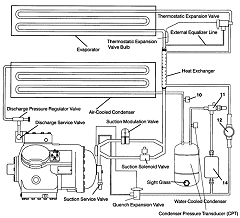In the Carrier Transicold cooling circuit shown in Figure 14, valves are used to reduce the suction pressure. Both valves remain completely open as long as the supply air temperature is above the nominal value. Once the nominal value has been attained, the suction solenoid valve closes, and the suction modulation valve makes a fine adjustment until refrigeration performance is matched against the heat to be dissipated. If the supply air temperature continues to fall (for instance, because the external temperatures are low), the refrigeration unit switches off completely. If the decrease in temperature still persists, heating is finally switched on.
 |
Click on graphic to enlarge. Figure 14: Cooling circuit of an integral refrigerated container (Carrier Transicold 69 NT) with additional water-cooled condenser |